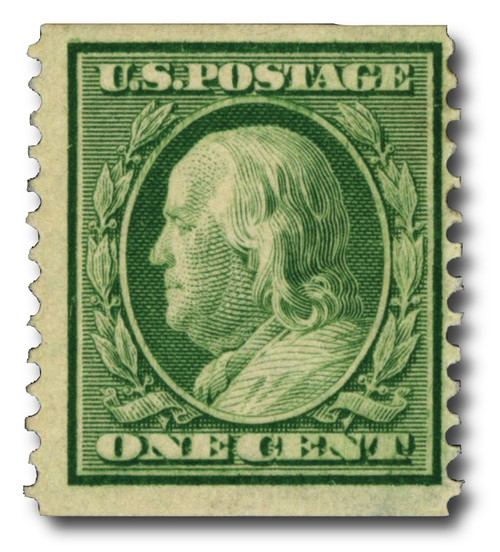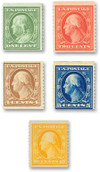
# 352-56 - Compete Set, 1909 Coil Stamps Perforated Vertically
Are You Missing These 1909 Washington-Franklin Coils?
Perforated 12 Vertically
The Washington-Franklins are among the most fascinating and challenging US stamps to collect. Issued between 1908 and 1922, they encompassed over 200 varieties, five different designs, two paper types, three printing methods, at least 14 perforations, several colors, and 20 denominations.
You can come one step closer to completing your Washington-Franklin collection with this convenient set of five mint stamps. Each of these coil stamps was perforated 12 vertically. Only 10,000 US #356 stamps were issued, making it especially rare and hard to find today. But you can get all five of these stamps in one convenient order.
Creating America’s Early Coils
On December 29, 1908, the Post Office Department ushered in a new era in both mail delivery and philately. That was the day the first coil stamps were made available at post office windows around the country. The Post Office Department had issued coil stamps once before, but only on an experimental basis, in five American cities. The experiment ended after a representative from the Post Office Department successfully “broke into” the vending machines used to sell the stamps.
The 1909 coil stamps were produced on a slightly modified version of the same flat plate press used to print sheet stamps. After the sheets were printed, they were sent through a perforating machine and perforated in only one direction. Then, the printed and perforated stamp sheets were fed into another machine that cut the sheets into twenty strips of twenty stamps each.
Because coils of only twenty stamps would not have been efficient for use in stamp vending machines, something had to be done to make the coils longer. Each of the strips had to be taken from the cutting machine by hand and glued end to end into coil rolls of either 500 or 1,000 stamps. This was the only step in the process that required manual labor. Soon, the Rotary Press would make it possible to nearly omit this step, thus automating the process almost entirely. Using the rotary press, workers only had to “paste-up” every 6,000 sheets!
Are You Missing These 1909 Washington-Franklin Coils?
Perforated 12 Vertically
The Washington-Franklins are among the most fascinating and challenging US stamps to collect. Issued between 1908 and 1922, they encompassed over 200 varieties, five different designs, two paper types, three printing methods, at least 14 perforations, several colors, and 20 denominations.
You can come one step closer to completing your Washington-Franklin collection with this convenient set of five mint stamps. Each of these coil stamps was perforated 12 vertically. Only 10,000 US #356 stamps were issued, making it especially rare and hard to find today. But you can get all five of these stamps in one convenient order.
Creating America’s Early Coils
On December 29, 1908, the Post Office Department ushered in a new era in both mail delivery and philately. That was the day the first coil stamps were made available at post office windows around the country. The Post Office Department had issued coil stamps once before, but only on an experimental basis, in five American cities. The experiment ended after a representative from the Post Office Department successfully “broke into” the vending machines used to sell the stamps.
The 1909 coil stamps were produced on a slightly modified version of the same flat plate press used to print sheet stamps. After the sheets were printed, they were sent through a perforating machine and perforated in only one direction. Then, the printed and perforated stamp sheets were fed into another machine that cut the sheets into twenty strips of twenty stamps each.
Because coils of only twenty stamps would not have been efficient for use in stamp vending machines, something had to be done to make the coils longer. Each of the strips had to be taken from the cutting machine by hand and glued end to end into coil rolls of either 500 or 1,000 stamps. This was the only step in the process that required manual labor. Soon, the Rotary Press would make it possible to nearly omit this step, thus automating the process almost entirely. Using the rotary press, workers only had to “paste-up” every 6,000 sheets!







